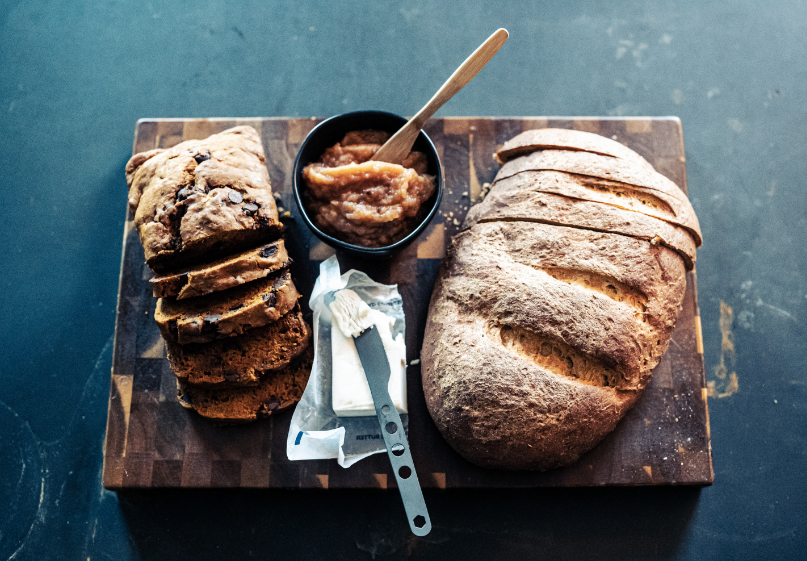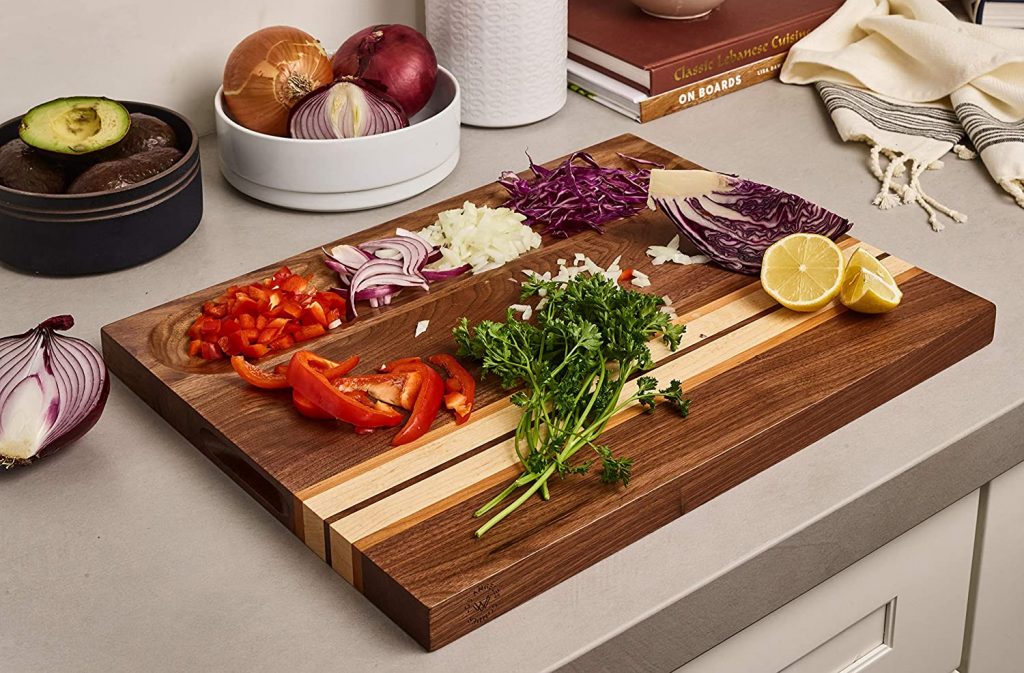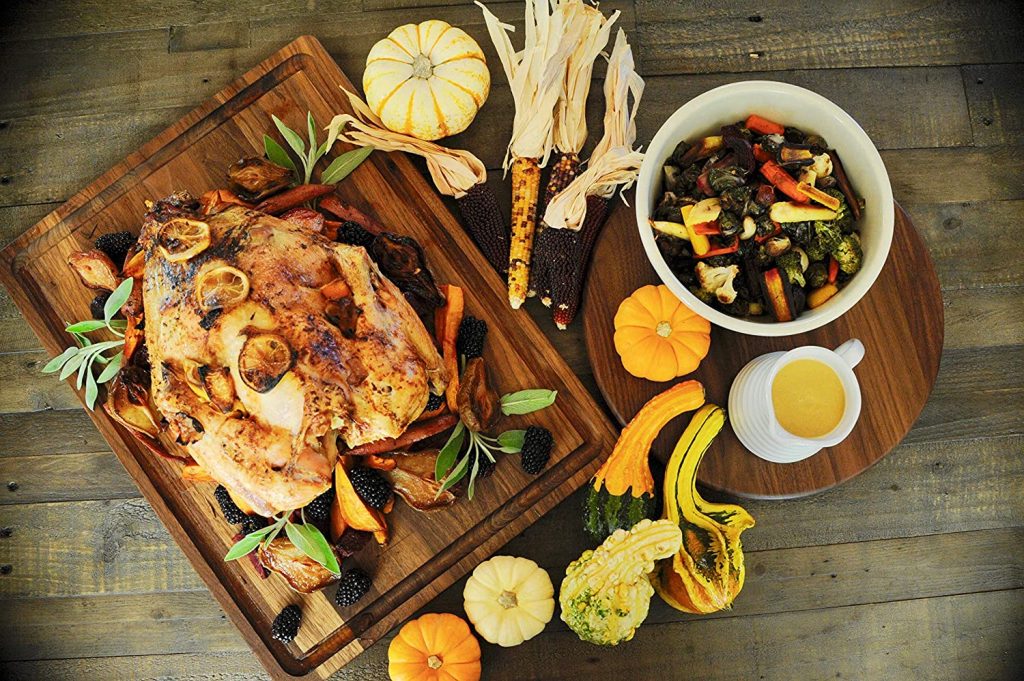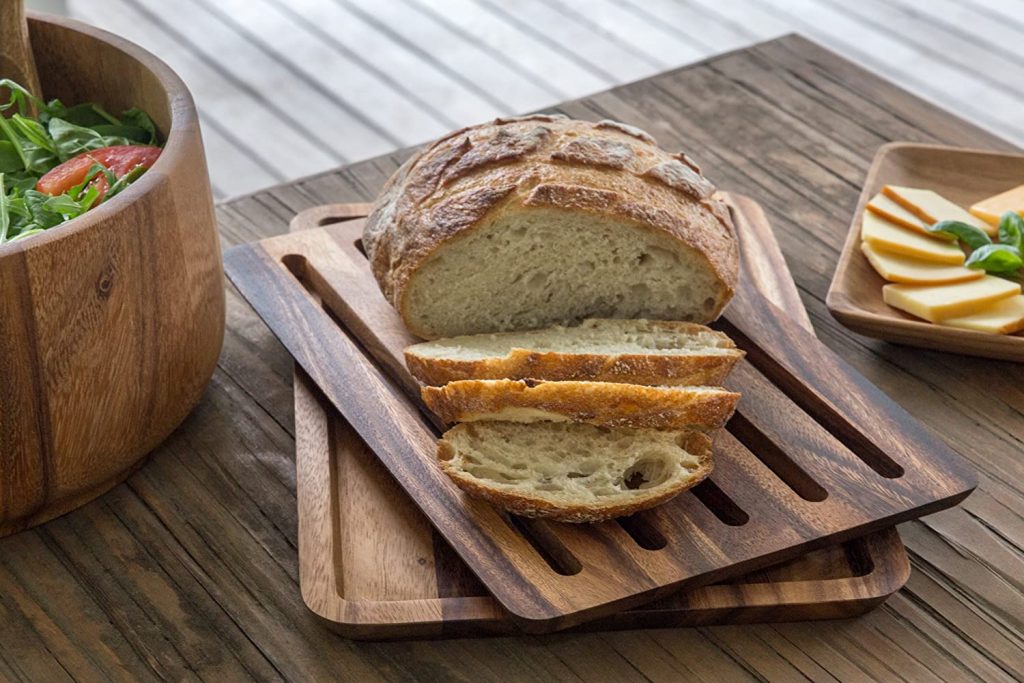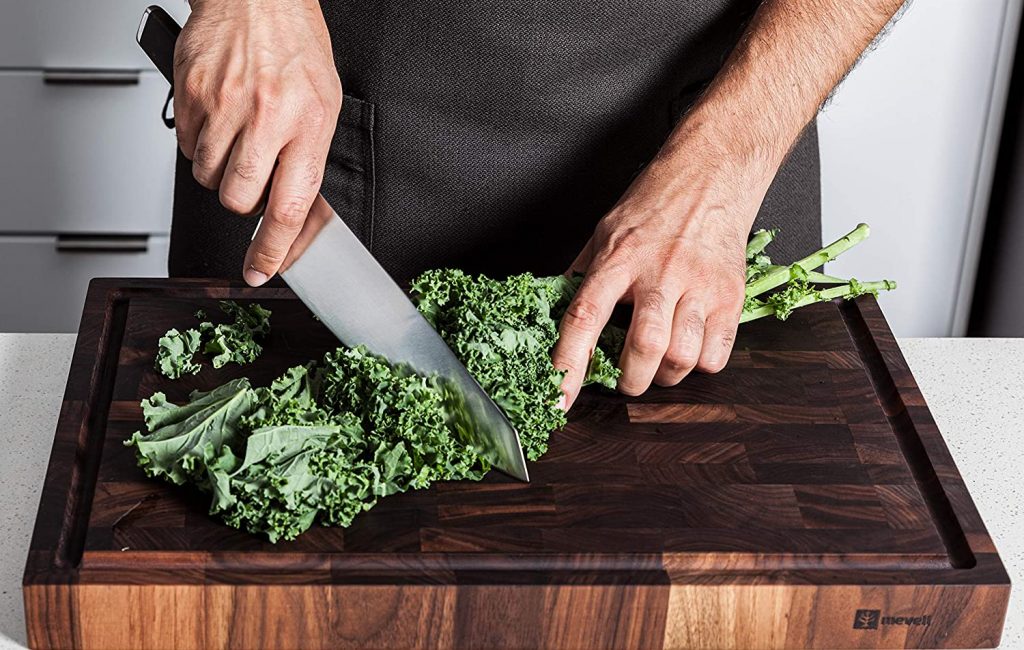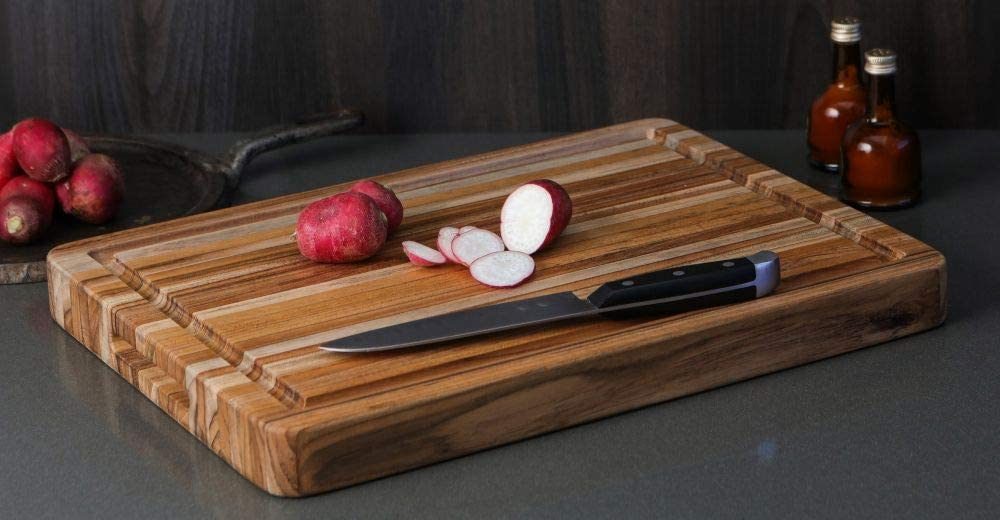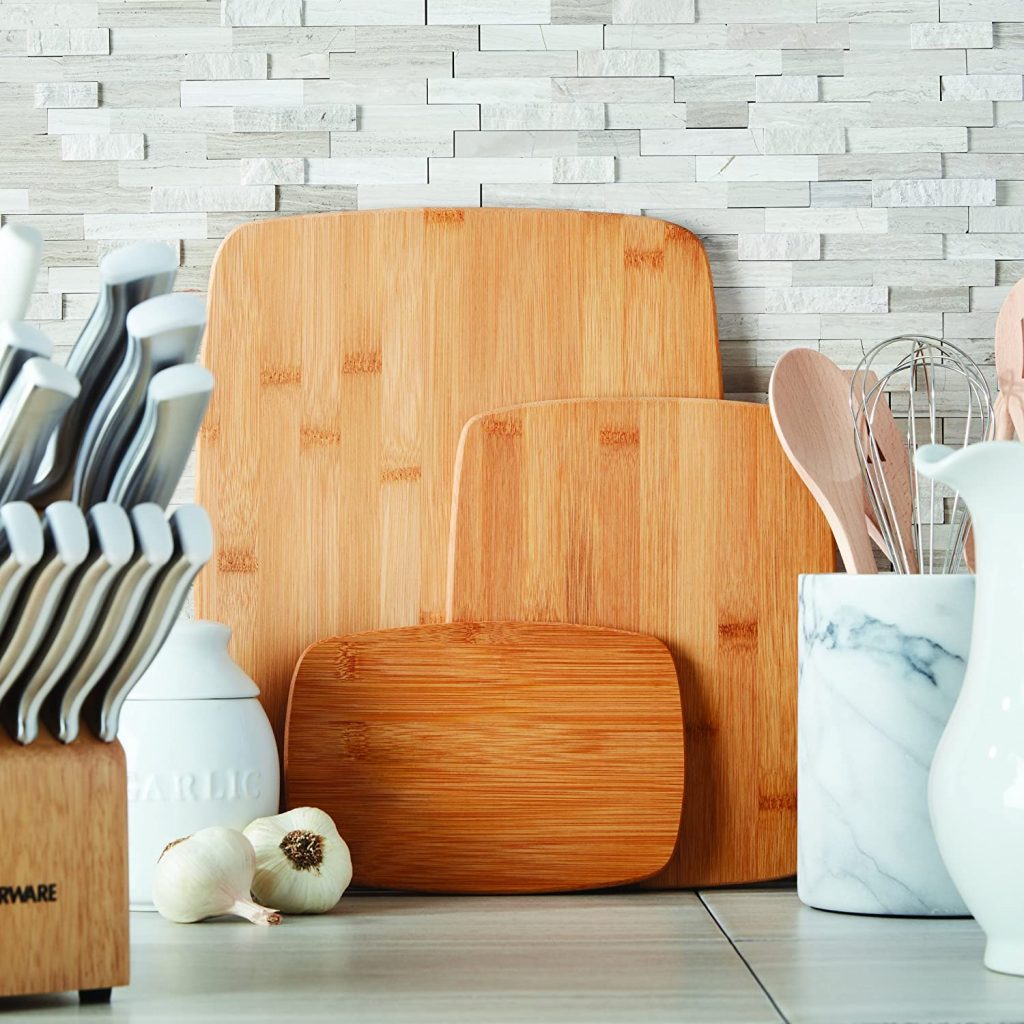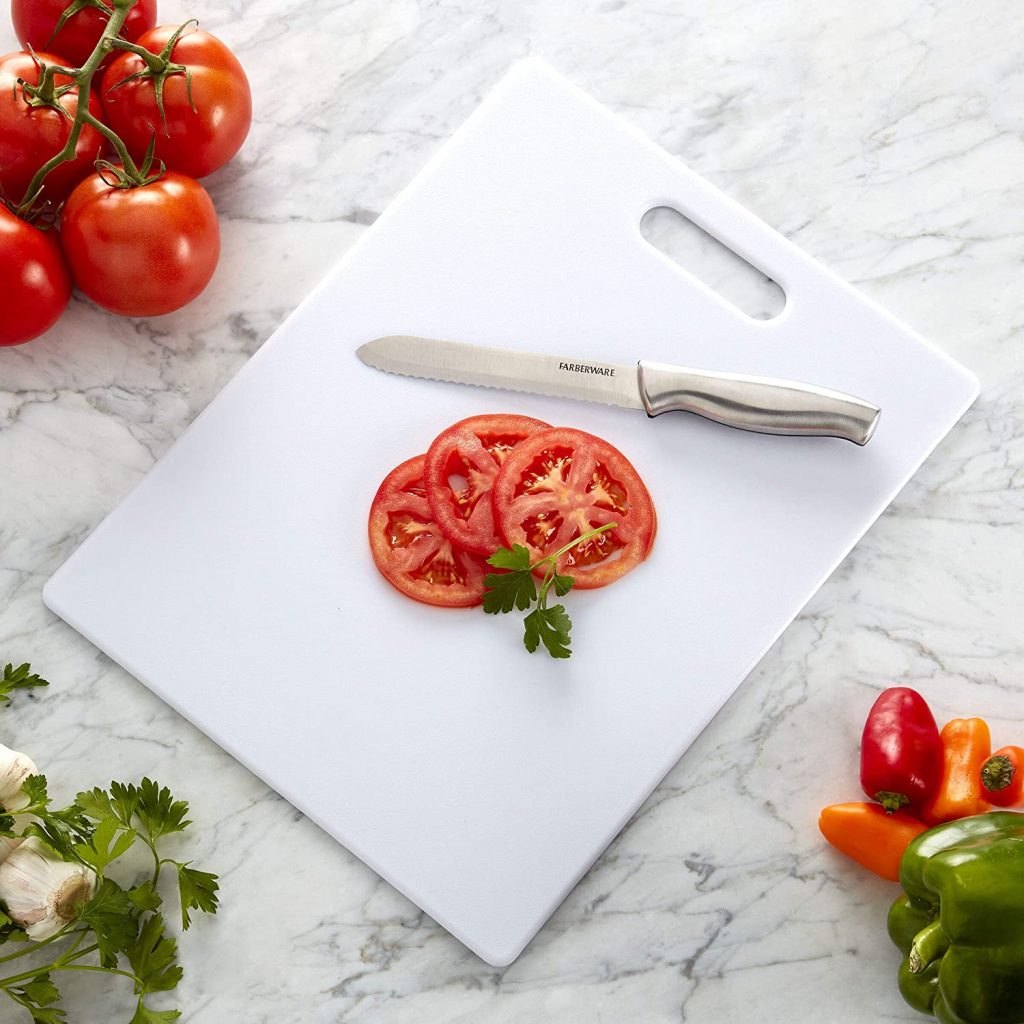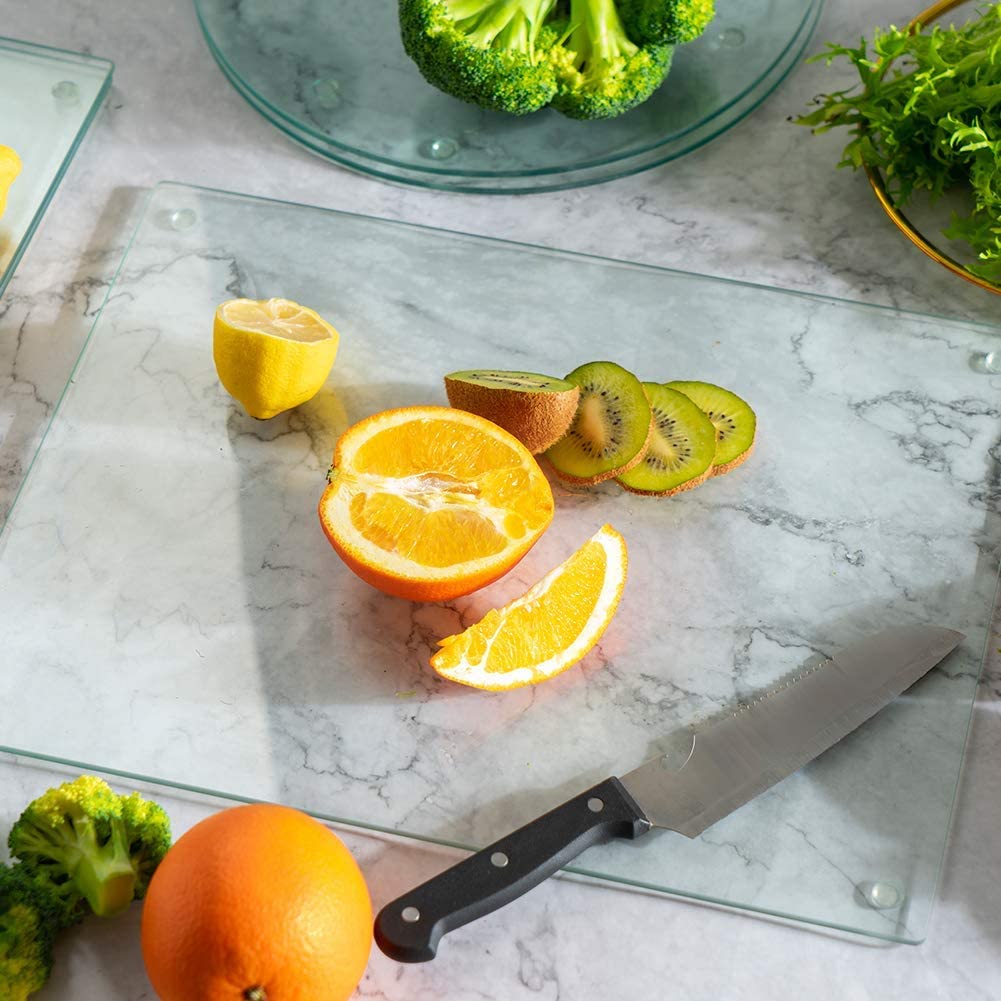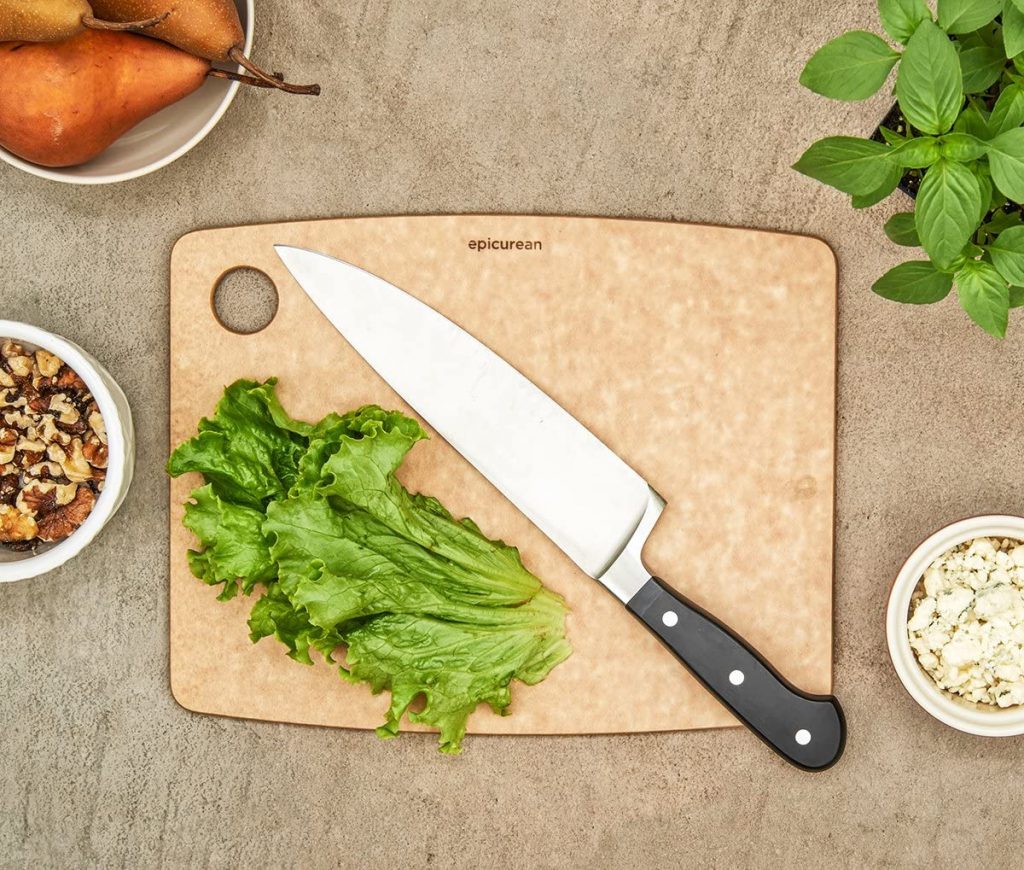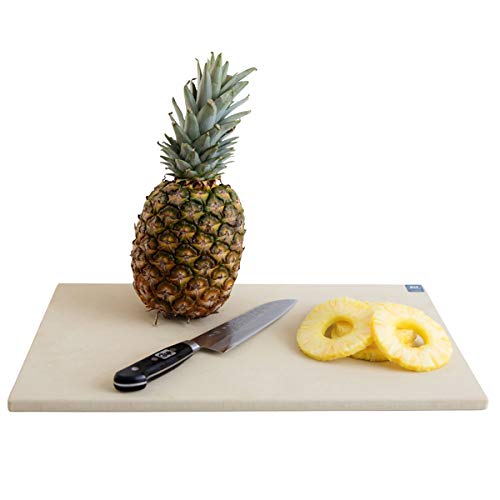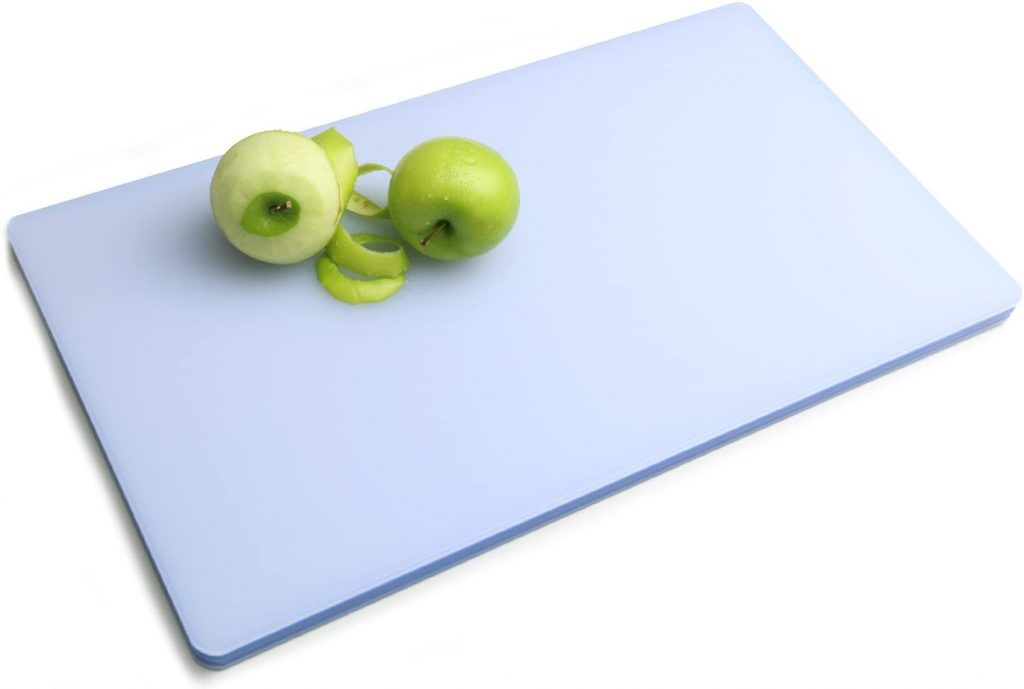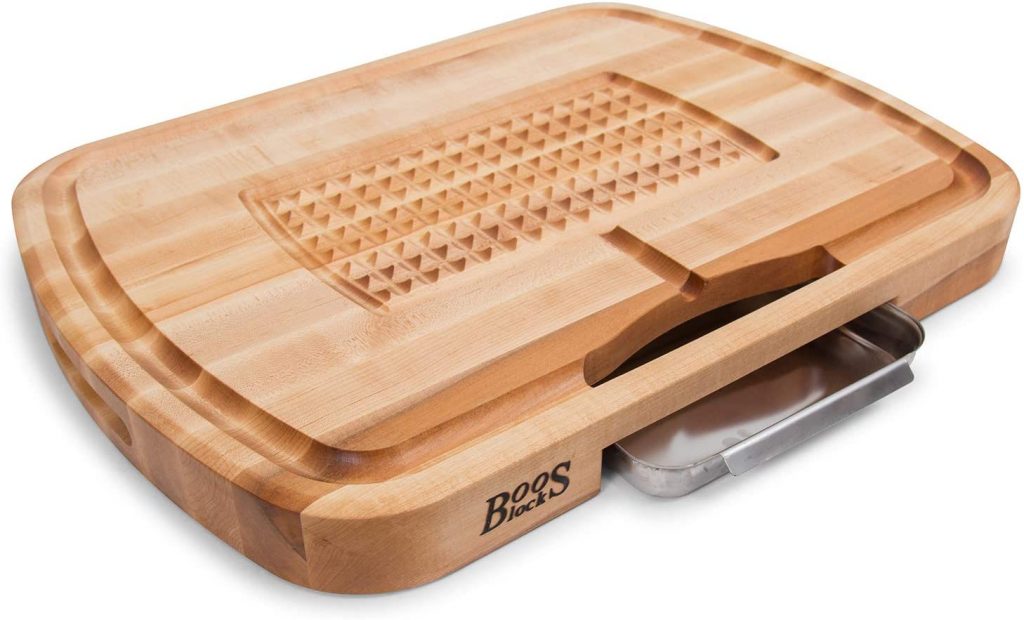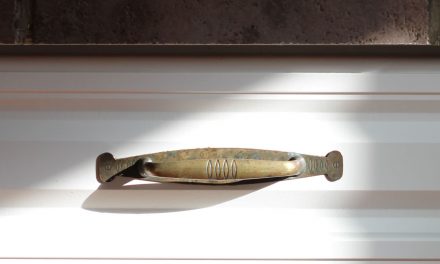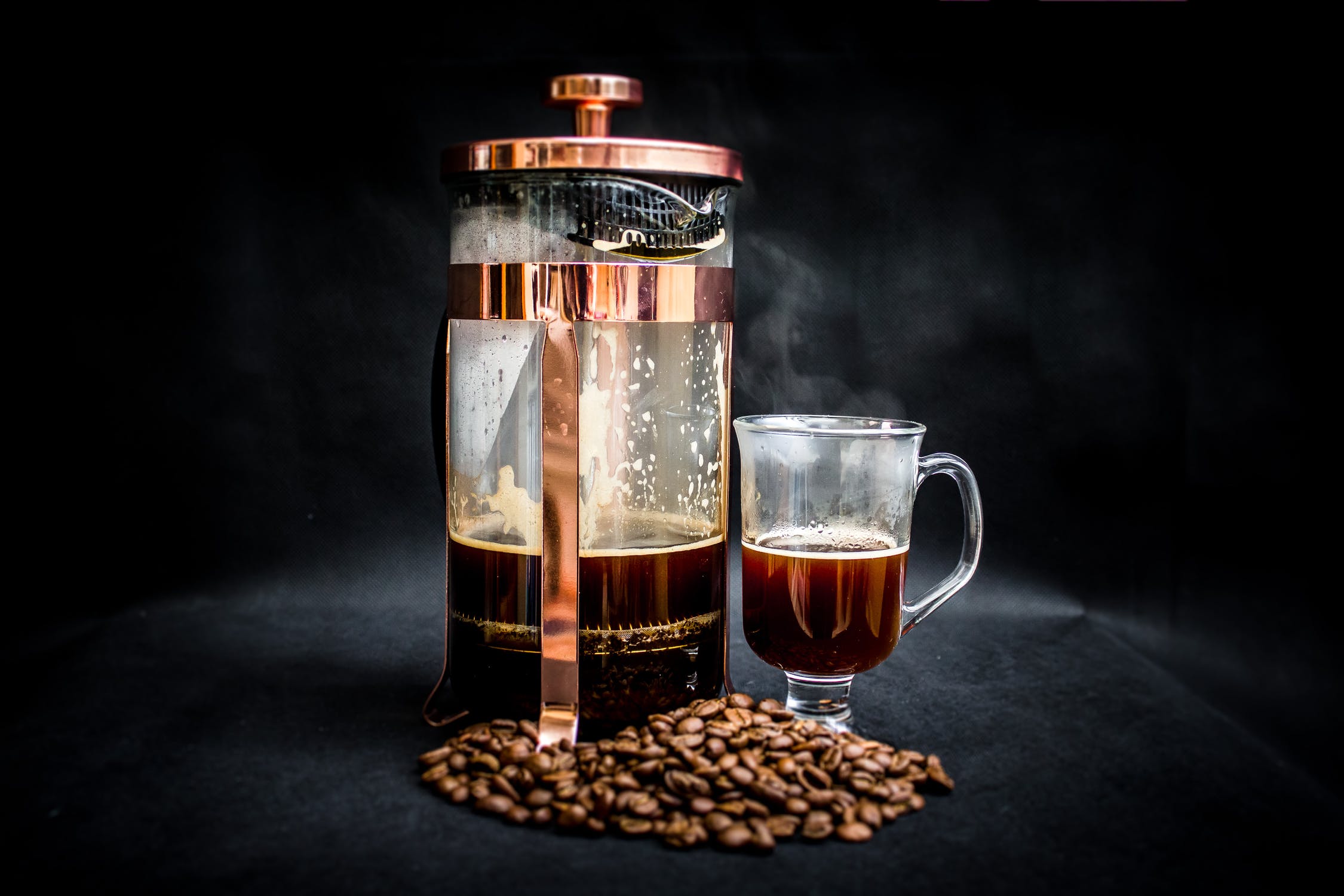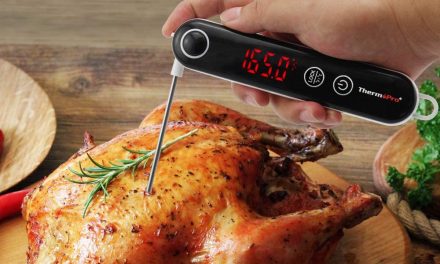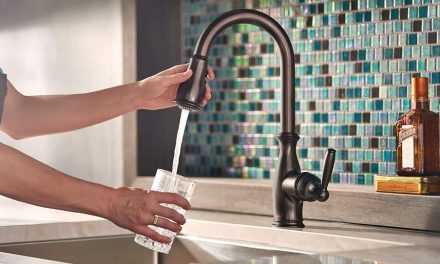Have you been thinking about replacing your cutting board? It’s possible for your cutting board to be full of nicks and scrapes, even if you barely use it. That’s because wear and tear adds up quickly on cutting boards. Not to mention, if you’ve been performing the wrong tasks on the types of cutting boards you own, you can’t be surprised if they aren’t lasting.
In this article, we’ll first go over the types of cutting boards, from classic styles to butcher blocks and more. Later, we’ll take a look at cutting board materials, which are best for what tasks, which are most sanitary, and how much they all cost.
x
Table of Contents
Types of cutting boards
Let’s get started with the different types of cutting boards at your disposal. From mats, blocks, and regular old boards, there’s actually a lot to choose from. Here we’ll talk about the different cutting board types, their uses, sizes, typical materials, and other features.
Classic cutting board
We’re kicking off our cutting board countdown with the classic cutting board. While cutting boards are available in many different materials (bamboo, plastic, composite, etc.), wood is still probably what you’re most likely to see.
As you’ll see with carving boards, many even classic-styled wood cutting boards are now reversible, offering one side for chopping and another for carving or some other task.
If you’re wondering about a standard size, there isn’t one. Sure, boards are available in small, medium, and large sizes, but there aren’t any set dimensions. However, the shape of the board will almost always be rectangular. The thickness of a classic wood board should be anywhere from around 1.25 to 2 inches to ensure durability.
Carving boards
Modern carving boards tend to offer a reversible feature, with one side designated for carving and the other for regular cutting. Carving boards are generally preferred in wood or bamboo construction, although you can find a few plastic ones out there, too.
The design includes raised edges to hold the meat in place and juice grooves to ensure there’s no mess to clean up after carving. These boards are available in multiple size variations, but the thickness of the panel will fall between 1 to 1.5 inches.
Breadboards (cheese boards, serving boards)
A bread cutting board is a great dining table accessory for dinners where you want slices of a freshly-baked loaf or any other type of bread. In general, this is partly what breadboards are ideal for: the display. Other foods you might highlight on them are cheeses, fruits, olives, and charcuterie.
These boards are available in quite a few variations, with some boards being longer, while others include slots on the surface to make for easier cutting. Some boards even come equipped with a removable tray so you can catch bread crumbs beneath it. The material used for these cutting boards includes wood or bamboo.
Butcher blocks
Butcher blocks were born when the industrial revolution caught up with the meat business. Back then, these boards were made from a single block of wood, such as hard maple, and lasted generations.
Modern butcher blocks are sometimes slimmer than their older counterparts. Nonetheless, any butcher’s block will still be thicker than your average cutting board. These products are either made of wood (acacia, teak, etc.) or bamboo. A few practical modern spins on butcher blocks include grooves and silicone/rubber legs to ensure safety.
Types of cutting board materials
From traditional wood to modern thermoplastics, cutting boards are available in a wide variety of materials. Here, we’ll take a look at the best options for cutting board materials, talk about which materials shouldn’t be used for cutting boards, and break down a few other considerations.
Wood cutting boards
Wood is a very traditional material for cutting boards and is often considered a good compromise between durability, price, and cutting smoothness. Wood boards are not especially hard on knives and have been used for thousands of years as cutting surfaces.
The best woods for cutting boards are hard, but not too hard, and tend to be dense and tough. They also tend to have smaller pores (called closed grain). Suggested cutting board woods include acacia, beech, cherry, maple, teak, and walnut. For best results, it’s generally best to avoid open grain (or ring porous) woods, like ash, elm, and oak, as well as softwoods, like cedar and pine.
There are three types of wooden cutting board—face grain, edge grain, and end grain. They get their names from the lumber industry. On a standard plank of wood (like a 2×4), the face is the widest surface, the edge is, well, the edge, and the end is the end. Face grain boards are likely to be the most attractive, as more of the grain of the wood is shown, but they’re also less durable and aren’t generally recommended for working boards.
An edge grain cutting board has been cut with the grain, which means these boards are relatively moisture resistant. They’re also the most affordable and common type of wooden cutting board. However, since you’re cutting against the wood grain, they show knife marks fairly easily.
End grain cutting boards are a little more high-end, and they’re the least likely to show knife marks or to dull knives. They are more expensive than edge grain boards, though, and they also tend to be heavier due to how they’re constructed. End grain boards are also more susceptible to moisture and require regular maintenance to keep the board from warping or harboring bacteria.
Are wooden cutting boards sanitary?
It has often been assumed that wooden cutting boards, being porous, are inherently more dangerous for raw meat than plastic boards. The bacteria in the meat or poultry can soak into the cutting board deeper than cleaning can reach.
However, the science is far from settled on this. There are even suggestions that wood may be more sanitary than plastic in some cases. Ultimately, whether you’d rather avoid wood cutting boards for handling meat and poultry is up to you. Whatever cutting board you choose should be regularly cleaned and well maintained for the best results. You should also use a different cutting board for raw meats than you use for fruits and vegetables.
| Wood Cutting Board Roundup | |
| Best for: | Especially good for hard vegetables. |
| Common features: | Juice grooves, textured surfaces |
| Size: | Ideally, edge grain cutting boards will be at least one inch thick, while end grain boards should be two. |
| Cleaning: | Cannot be washed in the dishwasher, but can be sanitized. May retain odors. The science is not settled on its safety for use with raw meat and poultry. |
| Durability and maintenance: | Reasonably durable, though it depends on the type. Must be seasoned with board oil regularly. |
| Cost: | Price varies widely depending on style, type of wood, and design. Basic edge grain cutting boards start at around $15 while end grain boards tend to be $50 at the lower end |
Bamboo cutting boards
Though bamboo products are often sold side-by-side with wood products, bamboo is not a wood. It’s a type of grass that grows in abundance in tropical and subtropical regions of the world. It’s for this reason bamboo cutting boards are a great eco-friendly alternative to wood.
Like wood, bamboo boards are also available in face grain, edge grain, and end grain varieties, with the same advantages and disadvantages. Bamboo tends to be less porous than wood, and bamboo boards are also generally cheaper and more durable. This durability, however, does have its downsides. Bamboo cutting boards are often hard on knives and can easily dull them.
While bamboo is generally more sustainable than wood, there are a few health concerns. Cheaper boards from less reputable manufacturers may be made with glues containing formaldehyde. Bamboo requires more glue to be made into a cutting board, so this is more of an issue with bamboo boards than with wood.
| Bamboo Cutting Board Roundup | |
| Best for: | Hard foods. Fruits and vegetables. |
| Common features: | Juice grooves |
| Size: | Available in similar thicknesses as wood. Keep in mind that bamboo boards are more dense than wood, so a similarly sized board will be heavier. |
| Cleaning: | Cannot be washed in the dishwasher, but can be sanitized. Similar issues/questions to wood when it comes to meat and poultry, though bamboo is less porous. |
| Durability and maintenance: | Very durable, though, like wood, it depends on the type. Must be seasoned with board oil regularly. |
| Cost: | Price depends on size and design, but bamboo tends to be cheaper than wood, with smaller boards available for less than $10 |
Plastic cutting boards
Plastic cutting boards are light, affordable, and come in a variety of colors and styles. Most plastic cutting boards are made of HDPE (high-density polyethylene), LDPE (low-density polyethylene) or PP (polypropylene), though some are acrylic or nylon. These are considered food safe plastics. Plastic cutting boards are available as both hard traditional boards and flexible cutting surfaces.
Hard plastic cutting boards are very much like wood cutting boards, though they tend to be thinner (generally much less than 1″ thick). They’re durable and easy to use, and aren’t too hard on your knives. They do, however, tend to slide on smooth countertops if they don’t have non-slip edges, and they scratch easily. Heavily scarred boards can be very hard to fully clean.
Flexible plastic cutting boards aren’t as durable and will likely have to be replaced often. Scratching is very common, and these boards are thin enough that you could cut right through them. However, they’re cheap, and their flexibility means they can be used for more than just cutting. They’re especially great for transferring chopped ingredients or even flour to a pan, since the edges can be pulled up to form a scoop shape.
| Plastic Cutting Board Roundup | |
| Best for: | Any food, though may have difficulty with harder fruits and vegetables |
| Common features: | Handle slots, nonslip edges, markers for types of food used on them |
| Size: | Hard plastic boards are generally less than ½”. Flexible ones are very thin, often around 1/32″. |
| Cleaning: | Dishwashers are not recommended, though they can be sanitized. Must be thoroughly (and carefully) scrubbed after use, especially if it’s scratched. |
| Durability and maintenance: | Reasonably durable, in that it is unlikely to shatter or crack, but highly prone to scratching and warping. If a plastic board becomes heavily scratched, it can no longer be effectively cleaned and needs to be replaced. |
| Cost: | Plastic is very affordable, with even larger, good quality boards available for less than $20. Flexible cutting boards are usually less than $5 a piece. |
Glass cutting boards
Glass cutting boards are highly resistant to knife marks and are extremely sanitary and easy to clean. They’re also, if made out of tempered glass, heat resistant and relatively durable. But that’s about all that recommends them. Their surface is very hard, which can quickly dull knives, and they may shatter when dropped. Their slickness means they can slide on smooth countertops, so nonslip corners are recommended.
In addition, knives can make very unpleasant sounds when sliding across glass. These boards may be better for kneading dough or smaller cutting jobs. But glass cutting boards are easy to clean, require no maintenance, and can be very beautiful, so if you don’t need a board that can survive rough use and aren’t concerned about your knives, it can be right for you.
| Glass Cutting Board Roundup | |
| Best for: | Avoiding cross contamination in homes with people with celiac disease or severe allergies |
| Common features: | Nonslip corners |
| Size: | Almost always less than ½” thick, though avoid any glass cutting board less than ¼” thick. |
| Cleaning: | Dishwasher safe and very easy to clean. Glass is totally nonporous, so it’s fine for all foods. |
| Durability and maintenance: | Tempered glass is relatively durable and scratch resistant. Maintenance is minimal. |
| Cost: | Vary a bit in price, but most are around $15-$30 |
Composite cutting boards
Composite cutting boards are made out of recycled cardboard, paper, and wood fiber that has been compressed into a hard piece and stuck together with resin. Also sometimes called wood-fiber laminate or stone wood, these cutting boards are incredibly durable.
Because of the high percentage of resin, composite cutting boards are even harder than bamboo and may dull knives. They’re unlikely to stain, require little maintenance, and are generally dishwasher safe. They are often thin, though, and may slide around on smooth counters if they don’t have nonslip corners.
Keep an eye out for low quality composite cutting boards and consider going with trusted manufacturers/brands, like Epicurean. Not all composites are equal, and some may be less durable than others. Some low quality composites have been known to flake or chip if the resin isn’t strong enough.
| Composite Cutting Board Roundup | |
| Best for: | Any foods. |
| Common features: | Handles, nonslip corners, juice grooves |
| Size: | Generally around ¼” thick. |
| Cleaning: | Dishwasher safe. Easy to sanitize. |
| Durability and maintenance: | Extremely durable and stain resistant. Requires very little maintenance. |
| Cost: | Price depends on size and manufacturer, but most are around $20-$60. |
Rubber cutting boards and silicone cutting boards
Rubber and synthetic rubbers can make excellent cutting boards. They combine durability with softness to be gentle on knives. These boards have a great feel while being used and aren’t harsh on wrists and hands. They originated in Japan for use by sushi chefs, and they’re great for more delicate foods, like mushrooms.
You never have to worry about a rubber board slipping, as these materials are naturally nonslip. They’re also heavy, which keeps them in place, though this may make storage more of a pain. Most rubber and synthetic rubber boards are semi-flexible, though thinner silicone boards can more closely resemble flexible plastic boards than their thicker, hardier cousins.
One newer material used for cutting boards is polyvinyl acetate (PVA). Sometimes called hi-soft, these synthetic rubber boards are made in a series of layers, meaning that when a layer gets too scratched, it can simply be sanded off, giving you a fresh cutting surface.
Another modern contender in the solid yet flexible arena is the TPU cutting board by Imeko. Made of food safe thermoplastic polyurethane, this board is thin (less than ¼”), soft, durable, and dishwasher safe.
Silicone cutting boards are a little easier to find in the US and are available in a much wider selection of colors, shapes, and sizes. They’re also a lot cheaper. They’re nice on knives like other synthetic rubbers, but they have a little less give. They’re also not quite as durable as rubber cutting boards.
Silicone is a good happy medium between plastic cutting boards and rubber cutting boards, having some of the advantages and disadvantages of both. One thing silicone does better than either, though, is heat resistance. You won’t necessarily want to put them in the oven, but they are dishwasher safe.
| Rubber and Silicone Cutting Board Roundup | |
| Best for: | Delicate foods |
| Common features: | Silicone may have inset handles and juice grooves. Rubber and Hi-Soft rarely come with additional features. |
| Size: | Rubber and hi-soft should be ½” to 1″ thick. Flexible silicone boards tend to be thinner. |
| Cleaning: | Rubber and synthetic rubber should not be washed in the dishwasher. Silicone is dishwasher safe and can also be sanitized. |
| Durability and maintenance: | Highly durable, though not necessarily stain proof or scratch resistant. Scratches and gouges can be rubbed off rubber and synthetic rubber boards. |
| Cost: | Silicone cutting boards are freely available for less than $20 with flexible varieties being less than $3 a piece. Rubber and synthetic rubber are pricier, $20-$140 depending on size. |
Materials that shouldn’t be used for cutting boards
While all the materials we’ve looked at had their advantages and disadvantages, there are some materials that just aren’t a good idea. Boards made of these materials should never actually be used as cutting boards. Some do still have uses, but as serving boards or cooling racks, not to cut on.
- Plastics other than HDPE, LDPE, PP. While all these plastics (designated by Resin Identification Codes 2, 4, and 5) have their advantages and disadvantages, they are food safe and relatively cleanable. Acrylic and nylon are also safe, even if their material properties may not be ideal. Other plastics, including polystyrene (styrofoam), polyvinyl chloride (PVC), and polyethylene terephthalate (PET) should be avoided.
- Stone. While stone cutting boards can be beautiful and striking, they are extremely likely to dull your knives. One of the most popular options for stone cutting board is marble, and while marble is soft (for stone), it’s still more than hard enough to damage your knives and is highly susceptible to damage from acidic foodstuff. Stone cutting boards can make wonderful serving trays, but avoid actually using them to cut food.
- Stainless steel. While stainless steel is durable, dishwasher safe, and very easy to sanitize, it is not recommended for cutting boards. Stainless steel and other metals that might be used in a kitchen setting will dull your knives extremely quickly. In addition, the especially slick surface of these materials can be hazardous, and metals other than stainless steel (like copper and aluminum) are likely to stain and discolor.
- Stoneware. Stoneware and other ceramics do not make good cutting boards. Their hard surfaces can dull knives, they’re relatively fragile, and they tend to be somewhat porous, making them not especially hygienic either. In addition, stoneware can contain small amounts of lead, which, while not necessarily a problem in stoneware vessels, may be an issue in a cutting surface.
What to look for in a cutting board
Materials aside, what else makes for a good cutting board?
Size
Size is an important consideration, but the question isn’t really what size do I want, but which sizes? Most working kitchens are going to need multiple cutting boards—at least one for raw meat, one for everything else—and it’s often helpful to have boards in several different sizes. After all, you don’t really need the same size of board for mincing garlic as you do for butchering a chicken.
Cutting board sets can be a good place to start. One trick is to lay whatever knife you might want to use on a cutting board diagonally—there should be at least one inch of cutting board space on either end of the knife. Bigger is generally better, but keep in mind your counter space, your storage space, how you plan to use your board, and, of course, the price.
Heavier is almost always better too. If your cutting board is too heavy to handle, then consider a lighter one, certainly. Otherwise, though, it’s nearly always better to have a heavier board than a lighter one.
Shape
Most cutting boards are rectangular or rectangular with beveled (curved) edges. Square, round, and novelty-shaped cutting boards are also available. Shape isn’t especially important, so go with what you like best. Just keep in mind that, while they take up space, full handles can be helpful. And novelty shapes may just end up being annoying.
Other features you may want
- Handle or hand grip. Whether an integral hand grip, a reasonably sized cutout, or a full set of handles, it’s nice to be able to get a grip. Some cutting boards have very small holes to hang them up. These can be useful, but they tend to make bad handles.
- Juice or blood groove. Between juicy fruits and vegetables, juices from fresh or cooked meat, and bread crumbs, it’s nice (and more sanitary) to keep the mess in one place. Some cutting boards have a narrow lip around the edge instead, which can also hold in juices but may make a smooth cutting action harder.
- Nonslip corners. Especially important for slicker materials, like glass and plastic, nonslip corners are always helpful, but they may mean your cutting board can’t really be reversible.
- Reversible. A reversible cutting board has twice as many surfaces to use, cutting down on wear and possibly giving you more options. Win-win.
- Textured surface. Not great all the time, but a patch of textured surface on a cutting board makes it great for butchering meat.
- Drip tray/crumb tray. A drip or crumb tray isn’t necessary in all cutting boards, but sometimes (especially when carving large pieces of meat) it can be really nice to have. Some cutting boards will have other trays (or cups) inset into the board. These are for separating out ingredients, but unless you have a specific need for them, they’re really not necessary.
Cutting board starter kit
If you’re used to home-cooked food or reserve culinary experimentation for the weekends – a cutting board is a valuable device. It can double as a trivet for pots, a charcuterie board, and most importantly, it can keep your countertops and dishes from scratches.
They’re available in various sizes, thicknesses, and materials. If you’re feeling a little lost about how to go around picking the right cutting board for your regular use, take a moment to go through our starter kit for some helpful pointers.
For Meat Enthusiasts: If you’re a big fan of poultry, beef, lamb, or fish, and if meat regularly features in all your dishes, then we recommend you opt for a cutting board or butcher’s block made of plastic. Gorilla Grip’s plastic cutting boards are especially great because they have non-slip edges and juice grooves. While the jury’s still out on whether wood is or isn’t sanitary and on whether plastic is, a big bonus to plastic is that it’s dishwasher safe. Unless you’re especially meticulous, your dishwasher is going to do a better job of cleaning than you will. Just remember to replace these when they start getting too many cut marks in them.
For Veggie Lovers: Folks who mostly eat vegetables can easily opt for plastic cutting mats, like those from the Nicole Home Collection, or wooden cutting boards.
For Lovers of Daily Bread and the Charcuterie Board: If you want freshly sliced bread with every meal or enjoy making beautiful charcuterie boards, get a breadboard. If you’re just looking to use it for bread, find one with a crumb tray, like the one from Ironwood Gourmet. For a more elegant serving board, take a look at these octagonal acacia boards from Renawe, and if you’re really looking to go all out, check out Royal Craft Wood’s large bamboo charcuterie platter.
For Folks with Eclectic Tastes: If you love meat, veggies, and fruits equally, your best best is to get your hands on a 3-piece cutting board set, like this bamboo set from Royal Craft Wood. Designate a different size for each food type and stick to it. That way, you won’t have to worry about cross-contamination.

